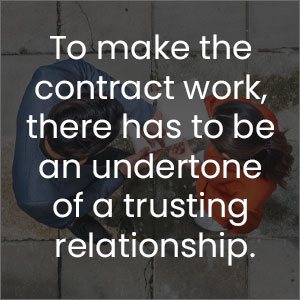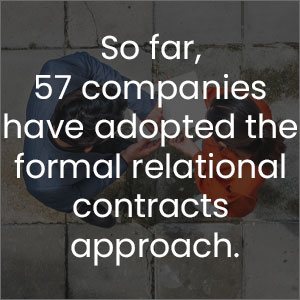In a previous blog post, I wrote about the idea of a relational contract. Upon further reflection, the world of contracts seems to be embarking on an entirely new path.
Contracts have become increasingly complex ever since the 1970s. Details and minutiae have become de rigueur. As a result, an interesting legal obsession started happening: chasing that perfect contract. You know, the contract that catches every eventuality, condition, and future situation? That’s when formal relational contracts began to emerge. And after an era of pursuing this ‘holy grail,’ there is a growing awareness that a more flexible framework is needed.
CONTRACTING’S NEGATIVE VORTEX
It’s not all that difficult to understand the origins of the traditional, super-detailed contract. It did not come from the feeling that all companies work with a common sense of reciprocity, autonomy, honesty, loyalty, fairness, and ethics. In fact, ‘for profit’ organizations drove a cold ‘winner takes all’ mentality, rather than one of relationship management.
Simply put, companies used contracts to protect against abuse in the relationship. Instead of a shared vision, the contract became the ultimate protection mechanism. It was crafted to ensure that no party gain benefits from a relationship at the expense of the other. Hence the propensity for increasingly detailed and lengthy contracts. With such an adversarial mindset, contracts fell into that negative vortex of tit-for-tat behaviors.
DEFINING THE FORMAL RELATIONAL CONTRACT
In the September-October 2019 edition of the Harvard Business Review, writers David Frydlinger, Oliver Hart, and Kate Vitasek defined the formal relational contract as follows:
“A formal relational contract is one that specifies mutual goals and establishes governance structures to keep the parties’ expectations and interests aligned over the long term. Designed from the outset to foster trust and collaboration, this legally enforceable contract is especially useful for highly complex relationships in which it is impossible to predict every what-if scenario.”
To make the contract work, there has to be an undertone of a trusting relationship. In effect, this new breed of agreement lays the foundation of trust. It isn’t meant as an articulation of every conceivable possibility, option, and eventuality. Instead, as companies agree to the terms, they agree to the notion that ‘business happens,’ and use reason and good, common sense whenever they need to resolve issues.
Ultimately, this new form of accord requires all parties to view the partnership as a long-term commitment. It is one that requires continuous improvement, in which case-by-case problem-solving is the mutual goal. This is instead of a five-step process to risk allocation, which I will discuss further below.
EMERGING AWARENESS
All of this certainly sounds good. But is this merely fanciful thinking? I would argue that a growing number of organizations are starting to take this approach with their agreements. Organizations that already use formal relational contracts include the Canadian government and the Australian Navy, as well as Dell, Intel, FedEx, Telia (Swedish telecom company), and AstraZeneca.
The nuances of the formal relational contract are emerging in conferences, too. One example is the FT/RSG Intelligent Business Forum, which included topics such as “Contract Humanism” and “Trust & Collaboration: The Rise of New Professionals.” Interestingly, Reena SenGupta, managing director of RSG Consulting, surmised at the forum that “a decent contract can be a blueprint for good human behavior.”
MITIGATING [RISK] FEAR
The ‘hold-up problem’ partly leads to the hundred-page contract. A term commonly used by economists, it refers to one party holding up the other on a particular issue. And let’s face it, every contract will have gaps – a clause forgotten or a level of ambiguity – that just cannot be helped.
The end result is organizations taking enormous efforts to mitigate these risks. In doing so, they make excessive investments that lead to rather poor outcomes. Beyond creating longer contracts, companies might choose several suppliers rather than one or add short termination clauses to the agreement. This may fix the hold-up problem, of course, but only adds costs in the first case. In the second, the party simply won’t make investments or efforts to innovate toward the greater good of both businesses. So all incentives become short-term.
Another challenge is that of ‘shading.’ This is a retaliatory act in which one party simply stops being cooperative, ceases to be proactive, or engages in tit-for-tat behavior. It happens when one participant believes that it is not getting its expected outcome from the deal, and feels that the other is to blame or simply is not being reasonable.
For instance, if demand for a product is lower than expected, a supplier may take a profit hit. Then, after refusing to adjust the fees laid out in the agreement, that same supplier may use a less costly but lower quality raw material. This would not be appreciated by the buying party, naturally, and would lead to another negative spiral – inevitably.
EXAMPLE: DELL VS. FEDEX
The Harvard Business Review detailed how Dell and FedEx used formal relational contracts to solve a similar shading problem, which was destroying the relationship between the two companies. Using the new long-term contracting paradigm, they each reduced costs by more than 40 percent and reduced scrap by nearly 70 percent. At the same time, they experienced record-low levels of their defective-parts-per-million targets. So far, 57 companies have adopted the formal relational contracts approach.
To date, 57 companies have adopted the formal relational contracts approach, according to the Harvard Business Review.
THE FIVE-STEP PROCESS
For both law firms and in-house counsel teams, the University of Tennessee legal scholars suggest these five steps as a framework:
- Build the foundation
- Share the vision and objectives
- Set guiding principles
- Align expectations
- Keep it aligned
Step one is all about building a partnership mentality. To make it work, there has to be trust underlying the relationship. This isn’t the right place for an ‘additional terms may apply’ mindset. Also, it isn’t about capturing every scenario in a clause. It’s about trusting each party to do the mutually right thing whenever circumstances arise.
Step two is about finding the greater cause for all parties. Build the vision of excellence in a product or service delivered to the ultimate customer. Then, set goals, and tactical and measurable metrics in order to monitor that vision jointly.
Step three is making clear the six guiding principles of reciprocity, autonomy, honesty, loyalty, equity, and integrity. They form the framework on how to resolve unexpected situations and any misalignment that may arise.
Step four is the contracting phase. But the key difference is that the terms and conditions of the formal relational contract are tightly aligned with these guiding principles. After all, it is important that the parties approach the development of an agreement with the right mindset, thinking of it as more of a joint problem-solving exercise.
The final step is all about moving forward in the spirit of the long-term relationship and contract. The best practice here is to set up governance teams on either side in order to monitor and adjust. This is where value creation, relationship management, partnership innovation, or simply product and delivery excellence come in. Joint teams create and maintain a long-term bond based on the guiding principles and social norms, instead of reverting to adding legally enforceable terminology that would only bring back that negative contract vortex.
ARE FORMAL RELATIONAL CONTRACTS IMPORTANT?
So is this truly an important issue? Is it really necessary to develop a new approach to these formal relational contracts?
Ultimately, the answer lies in whether you want your organization to stagnate or excel. We all want to avoid stagnating, of course. And that means continually experimenting with new techniques and methods.
Pointing out the importance of getting contracts right,’ IACCM President and Founder Tim Cummins suggested that “trade lies at the heart of human progress.” “Without trade, the economic world would collapse,” Cummins said. “This whole world is held together by contracts. Contracts underpin the entire social cohesion of business.”
When provided with such a powerful and profound picture of contracts, it becomes easy to understand the importance of progressing our science of contracting. Formal relational contracts are just an evolution in our legal industry, and more companies need to embrace them to their own mutual benefit.
Author:

Manpreet Dhillon
Connect with us on Linkedin
Further Reading:
- What to Look for in Contract Repository Software
- Corporate Counsels Are Using Outdated, Unsecure Technology to Manage Contracts
- What is Contract Termination





